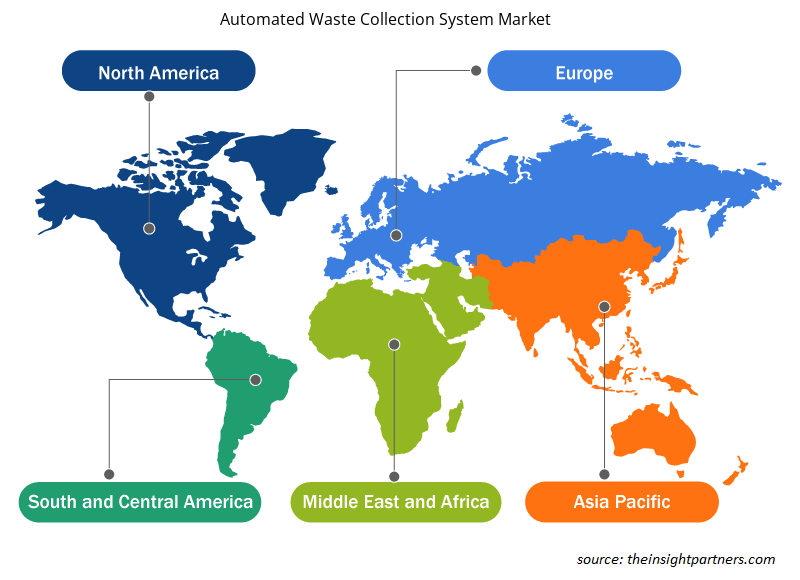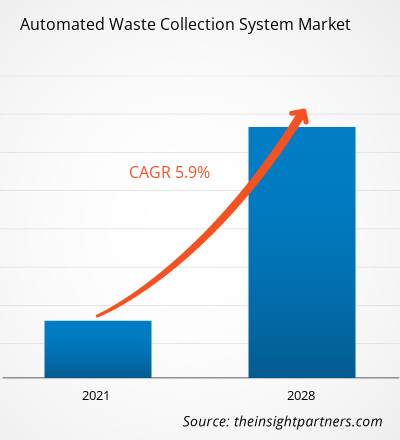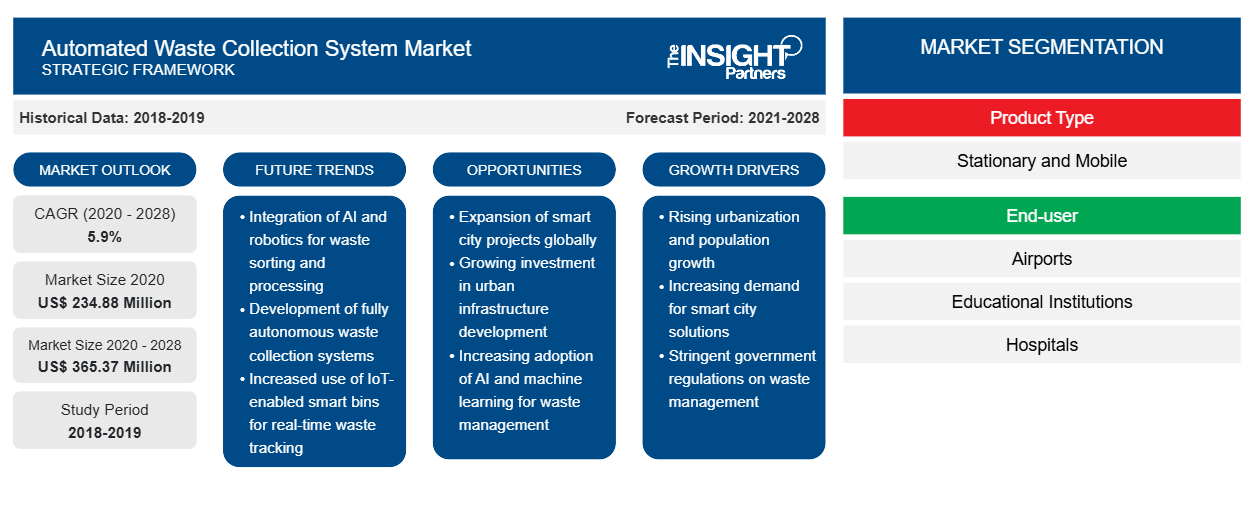بلغت قيمة سوق نظام جمع النفايات الآلي 234.88 مليون دولار أمريكي في عام 2020 ومن المتوقع أن تصل إلى 365.37 مليون دولار أمريكي بحلول عام 2028؛ ومن المتوقع أن ينمو بمعدل نمو سنوي مركب قدره 5.9٪ خلال الفترة 2021-2028.
العامل الرئيسي الذي يحرك سوق أنظمة جمع النفايات الآلية هو المبادرات الحكومية للتخلص السليم من النفايات. فرضت الهيئات الحكومية في جميع أنحاء العالم قواعد ولوائح لجمع وفصل النفايات. على سبيل المثال، حددت حكومة الهند قواعد جديدة لإدارة النفايات الصلبة تؤكد على فصل النفايات عند المصدر. تتطلب اللوائح الجديدة فصل النفايات عند المصدر لتوجيهها إلى رأس المال من خلال الاسترداد وإعادة الاستخدام وإعادة التدوير. لذلك، قبل تسليم النفايات إلى جامعيها، يجب على مولدي النفايات فرزها إلى ثلاثة تيارات - النفايات القابلة للتحلل الحيوي، والنفايات الجافة (البلاستيك والورق والمعادن والخشب وما إلى ذلك)، والنفايات المنزلية الخطرة (الحفاضات والمناديل ومبيدات البعوض وعوامل التنظيف وما إلى ذلك). ومع ذلك، فإن فصل النفايات على نطاق واسع هو عملية شاقة، مما يجبر السلطات الحكومية على التركيز على الحلول الآلية لفصل النفايات. تؤثر هذه العوامل على تبني أنظمة جمع النفايات الآلية في العديد من البلدان في جميع أنحاء العالم.
قم بتخصيص هذا التقرير ليناسب متطلباتك
ستحصل على تخصيص لأي تقرير - مجانًا - بما في ذلك أجزاء من هذا التقرير، أو تحليل على مستوى الدولة، وحزمة بيانات Excel، بالإضافة إلى الاستفادة من العروض والخصومات الرائعة للشركات الناشئة والجامعات
- احصل على أهم اتجاهات السوق الرئيسية لهذا التقرير.ستتضمن هذه العينة المجانية تحليلاً للبيانات، بدءًا من اتجاهات السوق وحتى التقديرات والتوقعات.
تأثير جائحة كوفيد-19 على سوق أنظمة جمع النفايات الآلية
ومع ذلك، فقد شهدت شركات تصنيع أنظمة جمع النفايات الآلية في جميع أنحاء العالم هزات محدودة حيث شجعت الحكومات الإقليمية والمحلية البلديات والمنظمات الخاصة على الاستثمار في حلول ذكية لجمع النفايات أو القمامة وفرزها. ومع زيادة أحجام النفايات السكنية بشكل كبير، ارتفع الطلب على أنظمة جمع النفايات الآلية بين القطاع السكني. ومع ذلك، بسبب الاضطراب في سلسلة التوريد الناجم عن تقييد الحركات البشرية، فقد أدى ذلك إلى تباطؤ نشر وتركيب AWCS في كل من البلدان المتقدمة والنامية مثل الولايات المتحدة وكندا والمملكة المتحدة وإيطاليا والصين. وقد جاء هذا في أعقاب اتجاه نمو الإيرادات الأبطأ من المعتاد في سوق أنظمة جمع النفايات الآلية العالمية
رؤى السوق - سوق نظام جمع النفايات الآلي
ارتفاع الاستثمارات في دمج أنظمة جمع النفايات الأوتوماتيكية
تحظى أنظمة جمع النفايات الآلية بتفضيل كبير في جميع مؤسسات الرعاية الصحية. تنقل أنظمة إدارة النفايات وجمعها المواد بسرعة 60 ميلاً في الساعة عبر شبكة أنابيب مخصصة محكمة الغلق من محطات التحميل في طوابق المرضى إلى عملية جمع مركزية. تُستخدم مسارات منفصلة لنقل النفايات والسماد والبياضات المتسخة إلى صناديق التجميع المناسبة. يؤدي هذا إلى زيادة الاستثمارات في تقنيات التجميع الآلي في الصناعات مثل الضيافة والرعاية الصحية وتجارة التجزئة. على سبيل المثال، قامت شركة Logiwaste AB بتوريد ثلاثة أنظمة مختلفة لجمع النفايات الآلية إلى مستشفى كارولينسكا في ستوكهولم. ومن المتوقع أن تدير هذه الأنظمة أربعة أنواع مختلفة من النفايات، وهي النفايات المتبقية والورق والبلاستيك والتغليف الورقي. كما فازت شركة Logiwaste AB بعقود من شركة Tiller Öst في تروندهايم؛ ومستشفى كارلستاد المركزي؛ وGrilstad Marina في تروندهايم؛ وChina Life في بكين، لتوريد AWCS. وعلى نحو مماثل، تلقت شركة Atreo مشاريع لتوريد أنظمة جمع النفايات الآلية إلى مستشفى باركلاند، ومستشفى همبر ريفر، ومستشفى بريغهام والنساء، والمركز الطبي بجامعة تكساس ساوث ويسترن، وغيرها. وبالتالي، من المتوقع أن تعمل الاستثمارات المتزايدة من قبل المنظمات من مختلف الصناعات، وخاصة الرعاية الصحية، لتنفيذ أنظمة جمع النفايات وإدارتها الآلية على تغذية نمو السوق في السنوات القادمة.
رؤى تعتمد على نوع المنتج
بناءً على نوع المنتج، يتم تقسيم سوق أنظمة جمع النفايات الآلية إلى أنظمة ثابتة ومتحركة. احتلت الأنظمة الثابتة حصة سوقية أكبر في عام 2020.
رؤى تعتمد على جودة المحتوى
بناءً على المستخدم النهائي، يتم تقسيم سوق أنظمة جمع النفايات الآلية إلى المطارات والمؤسسات التعليمية والمستشفيات والمكاتب المؤسسية والفنادق/المطاعم وغيرها. ومن المتوقع أن يسجل قطاع المطارات أعلى معدل نمو سنوي مركب خلال فترة التنبؤ.
يركز اللاعبون العاملون في سوق أنظمة جمع النفايات الآلية بشكل أساسي على تطوير المنتجات المتقدمة والفعالة.
- في عام 2021، نفذت شركة Caverion مشروعًا جاهزًا لبناء مبنى جديد لشركة التكنولوجيا الحيوية Thermo Fisher Scientific Baltics. تم تنفيذ المشروع في فيلنيوس، ليتوانيا.
- في عام 2021، اختار مستشفى جامعة ستافانجر نظام جمع النفايات والغسيل الآلي من شركة Logiwaste AB. يوفر النظام طريقة سهلة الاستخدام وفعالة وصحية للتعامل مع النفايات والغسيل، من باب المدخل وحتى المحطة.
رؤى إقليمية حول سوق أنظمة جمع النفايات الآلية
لقد قام المحللون في Insight Partners بشرح الاتجاهات والعوامل الإقليمية المؤثرة على سوق نظام جمع النفايات الآلي طوال فترة التوقعات بشكل شامل. يناقش هذا القسم أيضًا قطاعات سوق نظام جمع النفايات الآلي والجغرافيا في جميع أنحاء أمريكا الشمالية وأوروبا ومنطقة آسيا والمحيط الهادئ والشرق الأوسط وأفريقيا وأمريكا الجنوبية والوسطى.

- احصل على البيانات الإقليمية المحددة لسوق نظام جمع النفايات الآلي
نطاق تقرير سوق نظام جمع النفايات الآلي
| سمة التقرير | تفاصيل |
|---|---|
| حجم السوق في عام 2020 | 234.88 مليون دولار أمريكي |
| حجم السوق بحلول عام 2028 | 365.37 مليون دولار أمريكي |
| معدل النمو السنوي المركب العالمي (2020 - 2028) | 5.9% |
| البيانات التاريخية | 2018-2019 |
| فترة التنبؤ | 2021-2028 |
| القطاعات المغطاة | حسب نوع المنتج
|
| المناطق والدول المغطاة | أمريكا الشمالية
|
| قادة السوق وملفات تعريف الشركات الرئيسية |
|
كثافة اللاعبين في السوق: فهم تأثيرها على ديناميكيات الأعمال
يشهد سوق أنظمة جمع النفايات الآلية نموًا سريعًا، مدفوعًا بالطلب المتزايد من المستخدم النهائي بسبب عوامل مثل تفضيلات المستهلكين المتطورة والتقدم التكنولوجي والوعي المتزايد بفوائد المنتج. ومع ارتفاع الطلب، تعمل الشركات على توسيع عروضها والابتكار لتلبية احتياجات المستهلكين والاستفادة من الاتجاهات الناشئة، مما يؤدي إلى زيادة نمو السوق.
تشير كثافة اللاعبين في السوق إلى توزيع الشركات أو المؤسسات العاملة في سوق أو صناعة معينة. وهي تشير إلى عدد المنافسين (اللاعبين في السوق) الموجودين في مساحة سوق معينة نسبة إلى حجمها أو قيمتها السوقية الإجمالية.
الشركات الرئيسية العاملة في سوق نظام جمع النفايات الآلي هي:
- شركة خدمات النقل الجوي ايربين
- مجموعة ايه ام سي اس
- شركة كافيريوون
- شركة إنفاك إيه بي
- شركة لوجيواست اي بي
إخلاء المسؤولية : الشركات المذكورة أعلاه ليست مرتبة بأي ترتيب معين.

- احصل على نظرة عامة على أهم اللاعبين الرئيسيين في سوق نظام جمع النفايات الآلي
تم تقسيم سوق نظام جمع النفايات الآلي على النحو التالي:
سوق أنظمة جمع النفايات الآلية – حسب نوع المنتج
- ثابت
- متحرك
سوق أنظمة جمع النفايات الآلية – حسب المستخدم النهائي
- المطارات
- المؤسسات التعليمية
- المستشفيات
- المكاتب الرئيسية
- الفنادق / المطاعم
- آحرون
سوق أنظمة جمع النفايات الآلية – حسب المنطقة الجغرافية
أمريكا الشمالية
- نحن
- كندا
- المكسيك
أوروبا
- ألمانيا
- فرنسا
- إيطاليا
- المملكة المتحدة
- روسيا
- بقية أوروبا
آسيا والمحيط الهادئ (APAC)
- أستراليا
- الصين
- الهند
- اليابان
- كوريا الجنوبية
- بقية منطقة آسيا والمحيط الهادئ
الشرق الأوسط وأفريقيا
- المملكة العربية السعودية
- الامارات العربية المتحدة
- باقي منطقة الشرق الأوسط وأفريقيا
أمريكا الجنوبية (SAM)
- البرازيل
- بقية سام
نبذة عن الشركة
- شركة إيربين
- مجموعة ايه ام سي اس
- شركة كافيريوون
- شركة إنفاك إيه بي
- شركة لوجيواست اي بي
- ماري ماتيك أوي
- مايكو
- مجموعة إيفاك
- مابات
- بيئة STREAM
- التحليل التاريخي (سنتان)، سنة الأساس، التوقعات (7 سنوات) مع معدل النمو السنوي المركب
- تحليل PEST و SWOT
- حجم السوق والقيمة / الحجم - عالمي، إقليمي، بلد
- الصناعة والمنافسة
- مجموعة بيانات إكسل
التقارير الحديثة
شهادات العملاء
سبب الشراء
- اتخاذ قرارات مدروسة
- فهم ديناميكيات السوق
- تحليل المنافسة
- رؤى العملاء
- توقعات السوق
- تخفيف المخاطر
- التخطيط الاستراتيجي
- مبررات الاستثمار
- تحديد الأسواق الناشئة
- تحسين استراتيجيات التسويق
- تعزيز الكفاءة التشغيلية
- مواكبة التوجهات التنظيمية





















 احصل على عينة مجانية ل - سوق أنظمة جمع النفايات الآلية
احصل على عينة مجانية ل - سوق أنظمة جمع النفايات الآلية